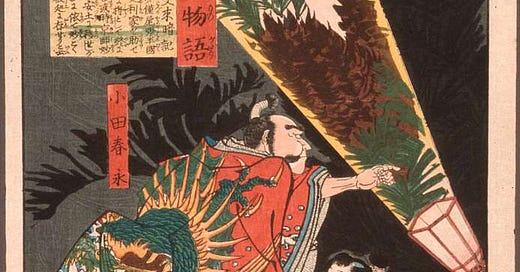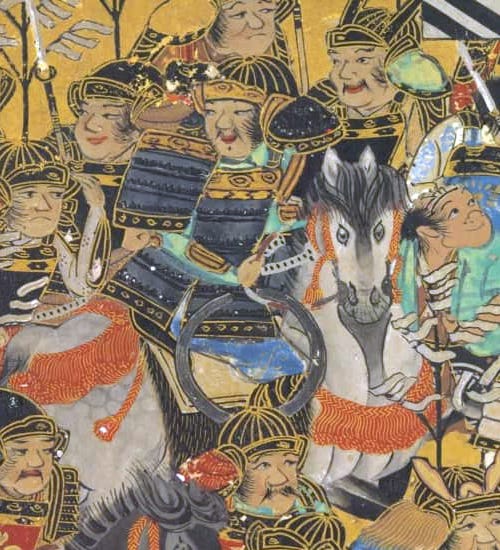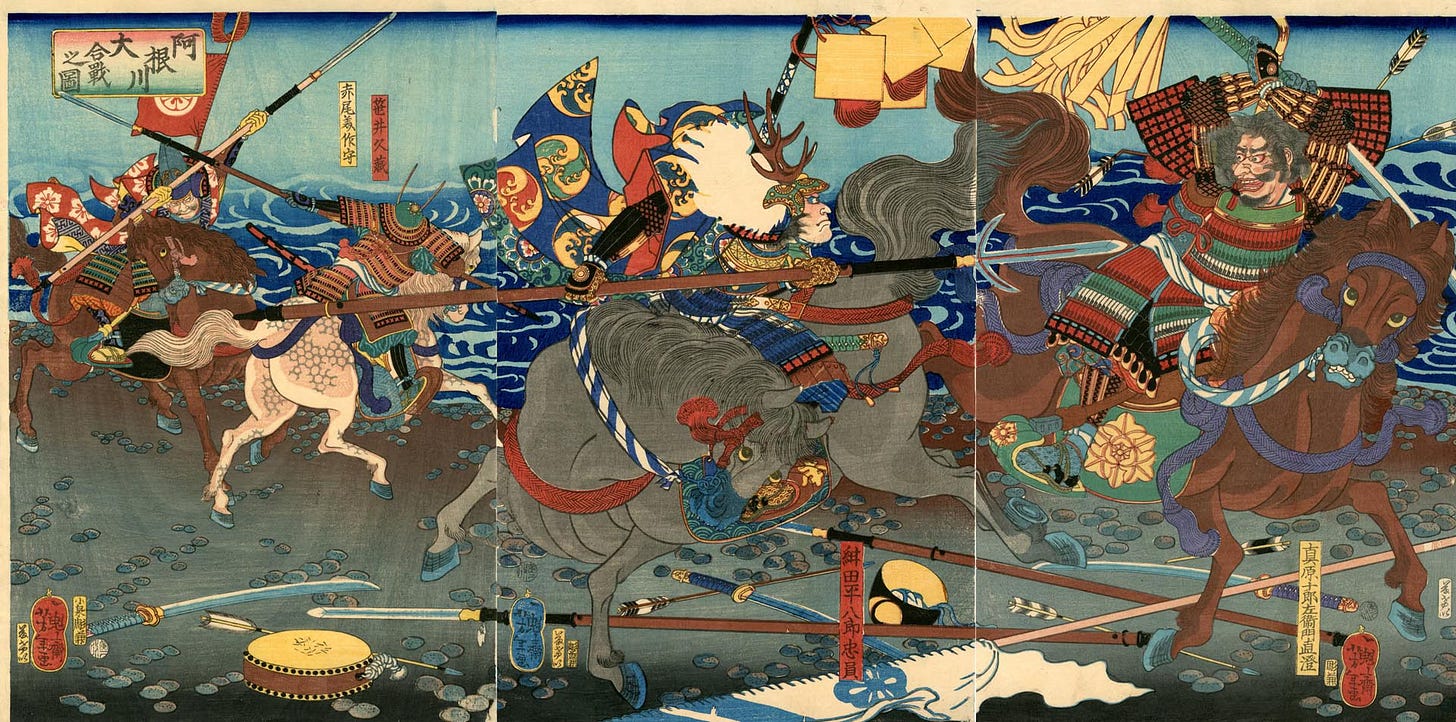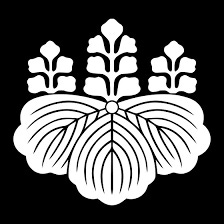Ono Harunaga (大野晴長) is best remembered as the Toyotomi stalwart and commander of Osaka Castle during the Winter and Summer Sieges of Osaka, for being a noted calligrapher and a tea master who studied under Furuta Shigenori Oribe, and for rumours that he had an affair with Toyotomi Hideyoshi’s wife Yodo-dono, and as such possibly sired Hideyoshi’s Toyotomi Hideyori.
Commonly known as Shuri-no-Jo, also Shuri-Tayu, or as Ono Shuri, Ono Harunaga was born in 1569, however his birthplace is often incorrectly identified as Ono Village, Tango County, Tango Province (northern regions of Kyoto Prefecture) where the Ono clan did indeed have lands and a castle, however this was long after Harunaga’s birth.
According to the Owari Gunsho Keizubushu, based on the Owari-shi and Choshu-zasshi records, Ono Harunaga was in fact born in Ono Village, Haguri County, Owari Province, (Aichi Prefecture) where the Ono clan had owned a castle. The Ono clan was originally a family of Iwashimizu Shrine officials, and Harunaga’s grandfather, Ono Harusada (also known as Iga no Kami), lost his priesthood and fled to Mino Province, where he built Ono Castle at the command of Oda Nobunaga, and made it his residence. Harusada’s son, Sadanaga and in turn Haruhisa, Sadanaga's younger brother (Harunaga's uncle) inherited Ono Castle.
As mentioned, his father was Ono Sadanaga (Sado no Kami) and his mother was Okurakyo no Tsubone. His brothers were Harufusa, Harutane, and Harusumi. According to the Nanro-shi records, Harunaga was a cousin of Mori Katsunaga, who was from the same hometown in Haguri County, Owari.
Harunaga’s mother also served as one of the three wet nurses to the daughter of warlord Azai Nagamasa and Oda Nobunaga’s younger sister, O-Ichi no Kata. The child was known as Chacha, later as Yodogimi and Yodo-dono (Lady Yodo) and as such she was considered a foster sister to Ono Harunaga. There are various theories about the year Yodo-dono was born, but considering this history, it is thought that Harunaga was roughly the same age as, or very close to her, so the most likely date is around 1569.
It is believed that Okurakyo no Tsubone and Harunaga had been attending to Yodo-dono ever since the fall of Odani Castle, and the death of Chacha’s (lady Yodo) father. On the fall of Odani, O-Ichi remarried her brothers’ trusted general, Shibata Katsuie. At the time of the Battle of Shizugatake and the destruction of Shibata’s Echizen Kitanosho Castle in 1583, Yodo-dono’s whereabouts are not clear, and it is unclear what became of the Ono clan stationed there either. However, during the Battle of Komaki and Nagakute in 1584, as the then head of the Ono clan, Harunaga rebelled against Toyotomi Hideyoshi and because of this, lost his clan territories including Ono Castle.
Despite this, Harunaga went on to become became a member of Hideyoshi's Umawari-shu, his personal elite guard, and while exactly when he received such a position is unknown, it is thought that this would have taken place around the time Yodo-dono (who was apparently in the care of either Oda Nobukatsu, Saji (Oda) Nobukata, or possibly Oda Nagamasu) came under Hideyoshi's protection, so it is assumed that this was around 1588, when Yodo-dono became Hideyoshi's concubine, or a little before that. Yodo-dono’s influence may well have played a key part in the commission.
In 1589, due to his parent’s achievements, Harunaga was given a total of 10,000 koku in Sano, Izumi Province and Ono, Tango Province, from the Taiko Treasury, and oversaw the territory from Ono Castle in Tango. (This may be one reason for the mistaken suggestion that he had been born in Tango province) This was apparently a reward or congratulatory increase in stipends in connection with Yodo-dono having given birth to Hideyoshi’s first son, Tsurumatsu in the same year.
Ono Harunaga first appears in reliable historical documents dated November 1591, when he accompanied Hideyoshi on his hunting expedition with the Kira clan in Mikawa Province.
The name Ono Shuri-no-Jo was listed on a map showing the layout of the camps at Hizen Nagoya Castle in Kyushu during the 1592 Korean Invasion. As he had done with the prolonged Siege of Odawara, Hideyoshi once again had his concubines such as Yodo-dono and Matsunomaru-dono at hand in the war camp. Yodo-dono became pregnant again that summer, giving birth to Hideyori the following year.
Ono Harunaga was later among the daimyo contributing to the construction of Fushimi Castle in 1594. At the time, he had a fief of 10,000 koku, borderline for daimyo status, but impressive all the same.
Upon his death in 1598, Toyotomi Hideyoshi left him 15 gold coins in his will. The following year Harunaga commenced serving Hideyoshi’s son, Toyotomi Hideyori and became his close aide as the head of the second group of elite guards.
However, on September of 1599, Tokugawa Ieyasu visited Osaka Castle to celebrate the double-nine (ninth day of the ninth month) celebrations with Hideyori, whom he rightfully served. At that time, Masuda Nagamori, one of the five magistrates, informed Ieyasu that there was a plot to assassinate him. The ringleader was Maeda Toshinaga, who had already returned to Kanazawa, and Asano Nagamasa, whose son, Yukinaga, was married to Maeda Toshiie's daughter, also Hijikata Katsuhisa, and Ono Harunaga were named in a conspiracy to assassinate Ieyasu inside the castle. Ieyasu made sure to keep his personal security tight, and after surviving the celebrations, he entered Osaka Castle’s Nishi-no-maru enclosure, where he built a castle tower as part of his residence within Osaka, demonstrating that he was on a par with Hideyori. He also began to crack down on the plotters, and on October 2, Harunaga was charged with a crime, exiled, and placed in the care of Ieyasu’s illegitimate son, Yuki Hideyasu in Shimousa Province. For the same crime, Katsuhisa was sent to the care of Satake Yoshinobu in Mito, Hitachi Province. Harunaga’s mother, Okurakyo no Tsubone, was also exiled from Osaka.
On July 24, 1600, Ieyasu held an audience with Harunaga and Hijikata Katsuhisa, and pardoned them both for their crimes.
During the Battle of Sekigahara, the recently forgiven Ono Harunaga fought on the side of the Tokugawa led Eastern forces, and in the main battle, was part of the vanguard of Fukushima Masanori's troops. According to the Sekigahara Gunki Taisei, he achieved military success by killing Ukita Hideie's musketeer, Koji Shichiroemon. Following the battle, Harunaga served as an emissary to the Toyotomi clan at Osaka Castle, carrying a letter from Ieyasu stating that he harboured no hostility toward the Toyotomi clan. Having delivered the letters, instead of returning to Edo, he remained in Osaka.
Siege of Osaka
Around June 22, 1614, Toyotomi Hideyori suddenly increased Ono Harunaga’s stipend by 5,000 koku along with that of Katagiri Sadataka, the younger brother of another Toyotomi stalwart Katagiri Katsumoto. This pay rise was due to Ieyasu's intercession and influence. To thank Ieyasu, Harunaga and Sadataka visited Ieyasu in Sumpu Castle in Suruga, and then paid their respects directly to Shogun Tokugawa Hidetada in Edo.
Surprisingly, later that year, Toyotomi clan elder Katagiri Katsumoto was exiled by a suspicious Yodo-dono, and Harunaga took the lead role in the Toyotomi clan. With Harunaga’s promotion, the pro-war faction became the majority within the Toyotomi clan, and Harunaga commenced the recruitment of ronin from across the country. The Tokugawa duly noted the increase in Osaka’s war preparations and began their own countermeasures. This led to the Winter Siege of Osaka. Together with Watanabe Tadasu, Harunaga became a Toyotomi clan magistrate, and led the siege as one of the central figures on the Toyotomi side.
When the Tokugawa proposed peace, Harunaga negotiated with the Tokugawa generals Honda Masazumi and Goto Mitsutsugu from December 8 to 12 together with mediation from Oda Yuraku (Urakusai). After compiling proposals and deals from both sides, including the demand for Yodo-dono being sent to Edo as a hostage, increasing the Toyotomi clan's stipends and those of the ronin of Osaka Castle, and the demolishing of Osaka Castle’s Ni-no-maru and San-no-maru compounds, leaving only the Honmaru, a peace agreement was reached. Oda Yuraku and Ono Harunaga agreed to provide and exchange hostages as a guarantee of peace, with Harunaga offering his second son, Yashichiro, to Ieyasu.
However, there were many Toyotomi loyalists within the castle who opposed the peace agreement. On the night of April 9, after the peace treaty was signed, Harunaga was ambushed at the tower gate of Osaka Castle, killing and wounding two of his guards, and he himself was wounded by a sword strike. This attack is said to have been orchestrated by his younger brother Harufusa, who was a supporter of the war faction, while the actual attacker was said to be a subordinate of Harufusa's vassal, Narita Kanbei. When the attack failed, Narita set fire to his house and committed seppuku, and his subordinates then fled to the Katagiri and Chosokabe residences, and some were arrested and confined by Morichika Chosokabe.
Peace did not last long.
During the Summer Siege of Osaka in 1615, Harunaga was initially in charge of defence of Osaka Castle’s main Honmaru Citadel. Harunaga was an old acquaintance of Sanada (Yukimura) Nobushige, who had served as Hideyoshi's horseman, and it is said that it was Harunaga who invited Nobushige to join the Siege of Osaka.
On April 28, prior to the attack on Asano Nagaakira at Wakayama Castle in Kii, Harunaga had sent his retainers Kitamura Zendayu and Ono Yagozaemon to instigate an uprising in Kii, but the plan failed. On June 5, during the Battle of Domyouji, Harunaga led the rear guard, but after the battle reached a stalemate, he withdrew with the Toyotomi forces. On the 7th, during the Battle of Tennoji, he was stationed to the northeast rear of Shitennoji Temple and south of Bishamon Pond as the rear guard for the entire army. It is commonly believed that he was expecting Hideyori to march out of the castle to lead his troops. This never eventuated, and the battle turned against the Osaka batallions.
Defeated, the seriously injured Harunaga retreated from Chausuyama. Around this time Hideyori is said to have considered exiting the castle and dyeing in battle but was dissuaded by Hayami Morihisa. Instead, he retreated into the main citadel and barricaded himself inside.
As a last resort, Harunaga unilaterally allowed Hideyori's wife, the daughter of the Shogun Hidetada, Senhime, to escape and use her as an emissary to plead with Ieyasu and Hidetada for the lives of Hideyori and his mother. On her arrival in the Tokugawqa camp the following day, the 8th, a deliberation took place among the Tokugawa. While Ieyasu showed some hesitation in accepting his granddaughter's request, Hidetada was furious that his own daughter, Senhime, did not remain by her husband’s side and commit seppuku with Hideyori, and refused to accept the pleas for the lives of Hideyori and his mother, Lady Yodo.
With their last hope gone, and Osaka Castle and its garrison on the verge of collapse, Harunaga and his men committed suicide together with Hideyori and Lady Yodo in the Yamazato Kuruwa of Osaka Castle. Harunaga’s own mother, Okurakyo no Tsubone, and his eldest son, Harunori, also committed suicide. He was 47 years old.
Affair With Yodo-dono
Since the early Edo period, there have been rumors that Harunaga had an affair with Yodo-dono, and was possibly the true father of Hideyori, and this is recorded in several books across the years.
It is highly possible, and quite probable that such rumours were merely the work of an Edo period novelist or playwright making scandalous accusations and character assassinations to attract the attention of the general public, and in some cases to achieve a political objective. (this was done particularly in regards to Oda Nobunaga and Toyotomi Hideyoshi during the Edo period) The more people welcomed them, the more distorted and subsequently widely known the stories became. Still, where there is smoke, there is fire, and Harunaga and lady Yodo did have a close, familial relationship. Indeed, as the leader of the Toyotomi clan who rebelled against Ieyasu, Ono Harunaga was made into a villain during the Edo period. It is only in recent time that this warriors’ merits have been realised and his important role in Sengoku period history recognised.









Harunaga was just one more to have been linked with rumours of being Hideyori's father. But he was a warrior of strenght, for sure.